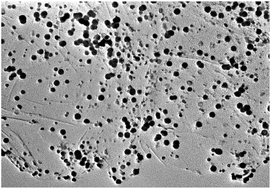In situ synthesis of porous SnO2 nanospheres/graphene composite with enhanced electrochemical performance
Abstract
A large diameter porous SnO2 nanospheres/graphene composite (p-SNG) was synthesized by a one-pot in situ hydrothermal method for the first time. XRD studies and FE-SEM, TEM images indicate that the porous SnO2 nanospheres with diameters of about 200 nm are distributed on the graphene nanosheets (GNS) uniformly. In comparison with the bare SnO2 nanospheres, the as-synthesized p-SNG exhibited enhanced initial charge and discharge capacity, superior cycle performance and rate performance. Electrochemical measurements demonstrated that the p-SNG composite delivered a reversible discharge capacity of 921.5 mA h g−1 at a current density of 400 mA g−1 after 50 cycles and a rate performance of 802.9 mA h g−1 at a high current density of 1600 mA g−1.


 Please wait while we load your content...
Please wait while we load your content...